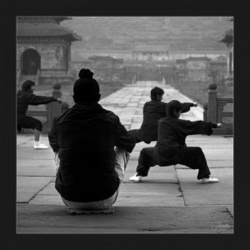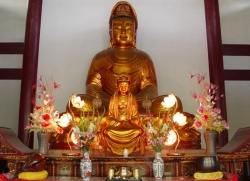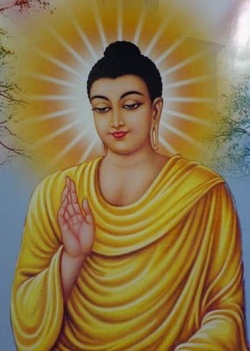San-Lun
The San-lun school is the Chinese form of the Indian Madhyamaka school. San-lun literally means "Three Treatise". It refers to the three written works fundamental for the school:
Madhyamaka-karika ("Memorial Verses on the Middle Teaching", by Nagarjuna): It has twenty-seven short chapters (400 verses). The main attempt is to refute the Hinayana teaching and also to analyze non- Buddhism teachings.
Shata-shastra ("Treatise on the Hundred Songs", by Aryadeva, 170-270, the fifteenth patriarch in the Indian lineage of Zen): The main attempt is to refute various philosophical theories opposed to Buddhism in order to show the real meaning of Mahayana.
Dvadashadvara-shastra ("Treatise of the Twelve Gates", by Nagarjuna): The main attempt is to refute the Hinayana teaching and other non-Buddhism teachings.
These three texts were translated into Chinese and provided with commentary by Kumarajiva (344-413) in the 5th century. Kumarajiva passed these texts on to his Chinese monk students. Among them Dao-sheng, Seng-jao, Dao-zong, and Seng-lang are the most outstanding scholars in the group and they are also the four major contributors who actually laid the foundation of this school.
In the 6th century the most important representatives of this school were Fa-lang (507-581) and his foreign student Chi-tsang (or Jia-shan, 549-623) and under them the San-lun school experienced a major upsurge, In the 7th century it was brought to Japan by Ekwan, a Korean student of Chi-tsang. After the appearance of the Fa-hsiang school, the San-lun school decreased in importance.
The school believes that each thing exists only in virtue of its opposite, all things are only relative and without essence (svabhavata), i.e. are empty (shunyata). In other words, the existence of one presupposes the existence of the other. Opposites are mutually dependent, therefore such entities can not really exist. The theory is based on the discussion of the experiential facts from the Prajnaparamita-sutra. From Nagarjuna's explanation, emptiness means the absence of an essence in thing but not their nonexistence as phenomena. The phenomenal world is characterized by manifoldness (prapancha), which is the basis of all mental representations and thus creates the appearance of an external world. To prove the theory can actually be experimental, a logical analysis is essential to the school. The methodological approach of rejecting all opposites is the basis of the Middle Way of San-lun. This middle position is clearly expressed in the "eight negations":
No creation (Chinese, "sian").
No elimination (Chinese, "mei").
No destruction (Chinese, "dwan").
No eternity (Chinese, "shang").
No unity (Chinese, "I")
No manifoldness (Chinese, "ie").
No arriving. (Chinese, "lai").
No departing (Chinese, "chui").
From this analysis, the San-lun school draws the conclusion the basic nature of the world is conditioned arising (pratitya-samutapada). It is unreal and empty, since through it none of the above eight phenomena (such as creation and elimination) are available.
Similar to other Chinese Buddhism schools, San-lun also undertakes a division of the Buddha's teaching into different categories. This school postulates that the Buddha's teaching can be categorized in "two paths and three turns". The two paths are:
The path of shravakas (lit., "hearer"): it is essentially the Hinayana teaching.
The path of bodhisattvas (lit., "enlightenment being"): it is the Mahayana teachings. The San-lun school is part of the path.
The school also distinguishes three phases of doctrine as three "turning dharma wheels". Turning, in other words, is the action of giving teachings. The dharma wheel is the content of the universal rules that lead the practitioners to the enlightenment. Each "turning dharma wheel" is a full cycle of teaching that satisfied various audiences in different circumstance:
Turning the fundamental wheel: The first phase is that of the Avatamsaka-sutra period, which represents the beginning of the Buddha's teaching career. This teaching was meant for bodhisattvas, other students at that time were not ready to understand this instruction.
Turning the application wheel: The second phase extends from the Agamas-sutra to the Lotus Sutra, includes all the teachings of the Hinayana and the Mahayana, is directed toward shravakas, pratyekabuddhas (lit., "solitary awakened one"), and bodhisattvas.
Turning the conclusive wheel: The third phase follows the period of the Lotus Sutra. In this period beings were ready to accept the conclusive single Buddha-vehicle (ekayana).



